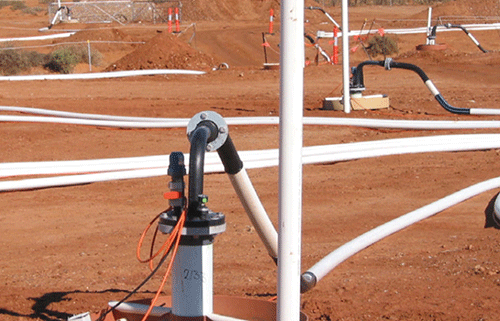LEONARDVILLE – Omaheke governor Pijoo Nganate last week urged Namibians to abandon what he called ‘fear of the unknown’ to allow Uranium One to continue with its controversial mining operations in the area. This is in stark contrast to a firm stance taken late last year by agriculture and water minister Calle Schlettwein, who said no uranium mining would be approved in order to safeguard the quality of scarce groundwater resources in the vicinity.
“If we allow this mining, Leonardville will be a different town, with a spillover to the entire region,” argued Nganate here in a speech at the Ritja career fair.
He also made specific reference to the tension triggered among some farmers, community leaders and government officials due to the close proximity of mining activity to a valuable water aquifer in the cattle-farming area. According to reported mining plans, the extraction of uranium will take place directly along the Nossob River and in close proximity to the aquifer located there.
Uranium One has been promoting the anticipated benefits of its proposed mining operations, stating that it could invest between US$300 million to US$500 million in the domestic economy over 25 years.
However, its suggested mining method called in-situ leaching (ISL) to extract the precious uranium is what is concerning stakeholders. ISL, also called in-situ recovery (ISR) or solution mining, is an extraction process used to recover minerals such as copper and uranium through boreholes drilled into a deposit.
The process initially involves the drilling of holes into the ore deposit. Afterwards, explosive or hydraulic fracturing may be used to create open pathways in the deposit for solutions to penetrate. A leaching solution is pumped into the deposit, where it makes contact with the ore. The solution bearing the dissolved ore content is then pumped to the surface and processed.
However, Schlettwein made it clear that the policy position is that no mineral exploration drilling and in-situ leaching activities shall occur in any aquifer. This position thus resulted in Uranium One having to await its mining exploration and extraction licence renewals. This was as mines minister Tom Alweendo said Uranium One’s drilling of boreholes was at a halt as new permits were being deliberated.
Career fair
Meanwhile, the company, remaining optimistic on the commencement of actual mining and to garner support from the local communities, sponsored career fairs in Leonardville and Gobabis last week.
The career fair was organised by Ritja, a Namibian non-profit organisation providing career path guidance to learners, and creating networking platforms for learners to interact and share information.
Uranium One spokesperson Riaan van Rooyen stated that they are availing eight bursaries for studies in areas like geology, geophysics, hydrogeology and chemistry. These bursaries are fully-paid for studies at any one of 10 Russian universities. The Government of the Russian Federation, in co-operation with Rosatom, Uranium One’s mother company, have made more than 200 bursaries available globally, of which eight are dedicated for Namibian students.
This initiative aims to develop a domestic workforce to work in the entity’s proposed Namibian operations. For this reason, students from Leonardville, Aranos, Aminuis and Gobabis will be given preference during the bursary selection process.
It is estimated that thus far, Uranium One has invested some N$2.5 million on corporate social responsibility (CSR), and has spent a further N$850 million on exploration processes.
According to Van Rooyen, the company has many more educational and upliftment programmes for Leonardville in the pipeline, of which most are expected to come to fruition during 2023-2024.
– mndjavera@nepc.com.na


